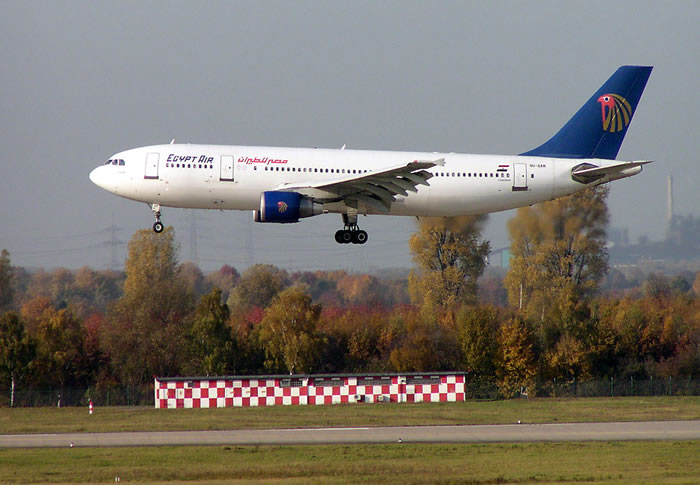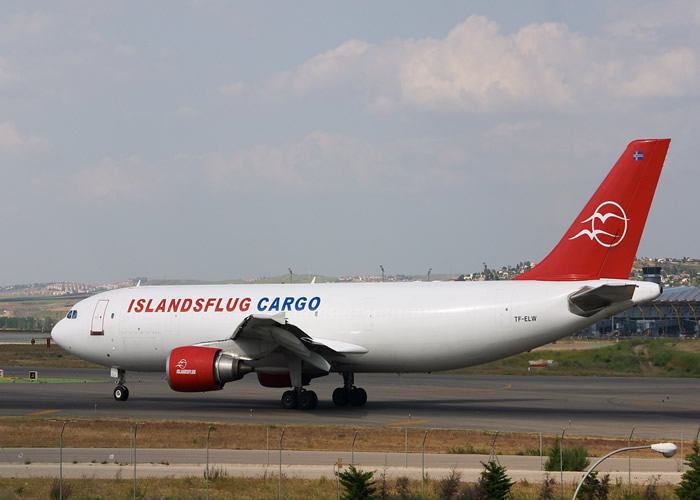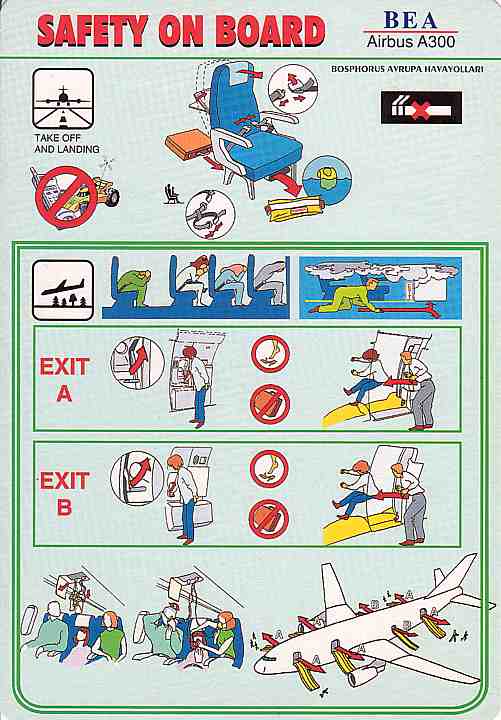
 |

THE BELOW LINKS CONTAIN DETAILED AIRLINE, MILITARY JETS, TEST AIRCRAFT, AIRPLANE FACT SHEETS AND AEROSPACE INFORMATION
THE BELOW LINKS CONTAIN AVIATION, MILITARY, AIRCRAFT VIDEOS, PICTURES, FACTS, INFORMATION, AUDIO, HISTORY, MOVIES AND PHOTOS

THE BELOW LINKS CONTAIN FLIGHT TRACKING, AIRPORT INFO, AVIATION PIONEERS, USAF REFERENCES, NTSB FACTS AND AVIATION WEATHER
THE BELOW LINKS CONTAIN INFORMATION ON AIRLINES IN CURRENT SERVICE TODAY AND ALSO BANKRUPT US AIRLINE COMPANIES (DEFUNCT)
AIRBUS A300 AIRCRAFT HISTORY, FACTS AND PHOTOS
 |
 |
The Airbus A300 is a short- to medium-range widebody aircraft. Launched in 1972 as the world's first twin-engined widebody, it was the first product of the Airbus consortium of European aerospace companies, wholly owned today by EADS. The A300 ceased production in July 2007, along with the smaller A310. Freighter sales for which the A300 competed are to be fulfilled by a new A330-200F derivative.
Development history French president Charles de Gaulle resented the US domination of civil aviation and wanted a European airliner that could compete with American designs.[citation needed] Concorde was part of the answer, designed for intercontinental routes; the other was the A300, designed to meet Kolk's US domestic requirements.
In September 1967, the British, French, and German governments signed a Memorandum of Understanding (MoU) to start development of the 300-seat Airbus A300. An earlier announcement had been made in July 1967, but at that time the announcement had been clouded by the British Government's support for the Airbus, which coincided with its refusal to back British Aircraft Corporation's (BAC) proposed competitor, a development of the BAC 1-11 — despite a preference for the latter expressed by British European Airways (BEA).
In the months following this agreement, both the French and British governments expressed doubts about the aircraft. Another problem was the requirement for a new engine to be developed by Rolls-Royce, the RB207. In December 1968, the French and British partner companies (Sud Aviation and Hawker Siddeley) proposed a revised configuration, the 250-seat Airbus A250. Renamed the A300B, the aircraft would not require new engines, reducing development costs. To attract potential US customers, American General Electric CF6-50 engines powered the A300 instead of the British RB207. The British government was upset and withdrew from the venture; however, the British firm Hawker-Siddeley stayed on as a contractor, developing the wings for the A300, which were pivotal in later versions' impressive performance from short domestic to long intercontinental flights.[citation needed] (Years later, through British Aerospace, the UK re-entered the consortium.)
Airbus Industrie was formally set up in 1970 following an agreement between Aérospatiale (France), the antecedents to Deutsche Aerospace (Germany) . They were to be joined by the Spanish CASA in 1971. Each company would deliver its sections as fully equipped, ready-to-fly items. In 1972 the A300 made its maiden flight. The first production model, the A300B2, entered service in 1974. Initially the success of the consortium was poor, but by 1979 there were 81 aircraft in service. It was the launch of the A320 in 1981 that established Airbus as a major player in the aircraft market — the aircraft had over 400 orders before it first flew, compared to 15 for the A300 in 1972. The A300 was the first airliner to use just-in-time manufacturing techniques. Complete aircraft sections were manufactured by consortium partners all over Europe. These were airlifted to the final assembly line at Toulouse-Blagnac by a fleet of Boeing 377-derived Aero Spacelines Super Guppy aircraft. Originally devised as a way to share the work among Airbus's partners without the expense of two assembly lines, it turned out to be a more efficient way of building airplanes (more flexible and reduced costs) as opposed to building the whole airplane at one site. This fact was not lost on Boeing, which, over thirty years later, decided to manufacture the Boeing 787 in this manner, using outsized 747s to ferry wings and other parts from Japan. The A300 cemented European cooperation in aviation. Its first flight was commemorated on a French three franc stamp. Airbus partners employed the latest technology, some derived from the Concorde. On entry into service in 1974, the A300 was very advanced and influenced later subsonic airliner designs. The technological highlights include: Advanced wings by de Havilland (later BAE Systems) with: 2-man crew by automating the flight engineer's functions, an industry first After the launch, sales of the A300 were weak for some years, with most orders going to airlines that had an obligation to favor the domestically made product — notably Air France and Lufthansa. At one stage, Airbus had 16 "whitetail" A300s – completed but unsold aircraft – sitting on the tarmac. Indian Airlines was the world's first domestic airline to purchase the A300. These have now been retired. In 1977, U.S. carrier Eastern Air Lines leased four A300s as an in-service trial. Frank Borman, ex-astronaut and the then CEO, was impressed that the A300 consumed 30% less fuel than his fleet of Tristars and then ordered 23 of the type. This was followed by an order from Pan Am. From then on, the A300 family sold rather well, eventually reaching the current total of 858 on order or delivered. The aircraft found particular favour with Asian airlines, being bought by Japan Air System, Korean Air, Thai Airways International, Singapore Airlines, Malaysia Airlines, Philippine Airlines, Garuda Indonesia, China Airlines, Pakistan International Airlines, Indian Airlines, Trans Australia Airlines and many others. As Asia did not have restrictions similar to the FAA 60-minutes rule for twin-engine airliners which existed at the time, Asian airlines used A300s for routes across Bay of Bengal and South China Sea. In 1977, the A300B4 became the first “ETOPS compliant” aircraft – its high performance and safety standards qualified it for Extended Twin Engine Operations over water, providing operators with more versatility in routing. By 1981, Airbus was growing rapidly, with over 300 aircraft sold and options for 200 more planes for over forty airlines. Alarmed by the success of the A300, Boeing responded with the new Boeing 767. The A300 provided Airbus the experience of manufacturing and selling airliners competitively. The basic fuselage of the A300 was later stretched (A330 and A340), shrunk (A310), or modified into derivatives (A300-600ST Beluga Super Transporter). The A300 has reached the end of production, and the last A300 freighter has been completed and delivered. The largest freight operator of the A300 is FedEx, which, as of January 2006, had 95 A300/310 aircraft. United Parcel Service (UPS) also operates freighter versions of the A300. The final version was the A300-600R and is rated for 180-minute ETOPS. The A300 has enjoyed renewed interest in the secondhand market for conversion to freighters. The freighter versions – either new-build A300-600s or converted ex-passenger A300-600s, A300B2s and B4s – account for most of the world freighter fleet after the Boeing 747 freighter. In March 2006 Airbus announced the closure of the A300/A310 line making them the first Airbus aircraft to be discontinued. The final production A300 made its initial flight on 18 April 2007[3] and was delivered on 12 July 2007. It was an A300F freighter for FedEx. Airbus has announced a support package to keep A300s flying commercially until at least 2025. A300B1 Only two were built: the first prototype, and a second aircraft which was later sold for airline service (to Air Algérie) and has now been scrapped. It has accommodation for 259 passengers with a maximum weight of 132,000 kg and two General Electric CF6-50A engines of 220 kN thrust. |
© AviationExplorer.com - The Website For Aviation Enthusiasts |




